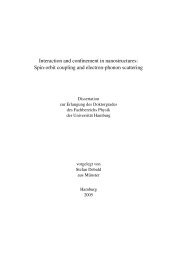Measuring the Electron Beam Energy in a Magnetic Bunch ... - DESY
Measuring the Electron Beam Energy in a Magnetic Bunch ... - DESY
Measuring the Electron Beam Energy in a Magnetic Bunch ... - DESY
Create successful ePaper yourself
Turn your PDF publications into a flip-book with our unique Google optimized e-Paper software.
super conduct<strong>in</strong>g cavities’ controllers would be sent commands from <strong>the</strong> central<br />
controller on an <strong>in</strong>tra-bunch-tra<strong>in</strong> basis with a moderate bandwidth, while <strong>the</strong> normalconduct<strong>in</strong>g<br />
RF cavity amplitude could be sent commands on a fast, bunch-to-bunch basis.<br />
Each super-conduct<strong>in</strong>g cavity would have its own, <strong>in</strong>dependent, fast, vector-sum<br />
controller feedback loop us<strong>in</strong>g multiple cavity pickups as <strong>the</strong> diagnostic references. All of<br />
this would be accomplished with a newly developed μTCA crate system; this is <strong>the</strong> crate<br />
system that will replace <strong>the</strong> exist<strong>in</strong>g VME <strong>in</strong>frastructure <strong>in</strong> <strong>the</strong> com<strong>in</strong>g years. The<br />
advantages of <strong>the</strong> system from Fig. 3.3.1(a.) <strong>in</strong>clude<br />
• <strong>the</strong> ability to use a high-level system identification algorithm to tune and<br />
stabilize <strong>the</strong> entire mach<strong>in</strong>e,<br />
• built <strong>in</strong> cross-checks and redundant measurements that use different<br />
techniques to measure <strong>the</strong> same quantities,<br />
• robustness afforded by distributed cavity controllers that do not require <strong>the</strong><br />
central controller to operate.<br />
The disadvantage is that with a centralized decision mak<strong>in</strong>g process, <strong>the</strong> latency of <strong>the</strong><br />
signal transport <strong>in</strong>creases due to <strong>the</strong> multiple digital processors and long cables to and<br />
from <strong>the</strong> central decision mak<strong>in</strong>g crate. The latency problems can be offset with <strong>the</strong> use<br />
of a normal conduct<strong>in</strong>g cavity with a low quality factor <strong>in</strong> which <strong>the</strong> accelerat<strong>in</strong>g field<br />
can be changed quickly. The alternative, more expedient architecture us<strong>in</strong>g exist<strong>in</strong>g<br />
hardware and distributed control loops, shown <strong>in</strong> Fig 3.3.1(b.), requires fewer digital<br />
processors and cable lengths that are shorter, however, <strong>the</strong> high quality-factor of <strong>the</strong><br />
super-conduct<strong>in</strong>g cavities used as actuators limits <strong>the</strong> speed with which <strong>the</strong> energy of<br />
each bunch can be adjusted. This means that <strong>the</strong> first 10 or more bunches of <strong>the</strong> tra<strong>in</strong> are<br />
un-stabilized.<br />
In Fig 3.3.1(b.), <strong>the</strong> photo-<strong>in</strong>jector laser phase is synchronized to <strong>the</strong> Master Laser<br />
Oscillator (MLO) <strong>in</strong> <strong>the</strong> same manner depicted <strong>in</strong> Fig 3.3.1(a.), but that is where <strong>the</strong><br />
similarity ends. The <strong>in</strong>jector RF phase is stabilized with a cavity controller that<br />
<strong>in</strong>corporates beam-based feedback from a beam arrival-time monitor downstream of <strong>the</strong><br />
first accelerator section, but upstream of <strong>the</strong> first chicane. The first accelerator section<br />
amplitude is stabilized with a cavity controller that <strong>in</strong>corporated beam-based feedback<br />
from an arrival-time monitor located directly after <strong>the</strong> first chicane. The first accelerator<br />
section phase is stabilized with a bunch-length monitor located after <strong>the</strong> second chicane.<br />
The second accelerator section amplitude and phase are stabilized <strong>in</strong> a similar fashion<br />
with an arrival-time monitor and a bunch length monitor after <strong>the</strong> second chicane.<br />
The system shown <strong>in</strong> Fig 3.3.1(b.) has <strong>the</strong> follow<strong>in</strong>g disadvantages<br />
• If an upstream feedback loop fails to deliver acceptable beam stability, <strong>the</strong><br />
downstream loop will start to feed back on noise that is generated some<br />
where o<strong>the</strong>r than <strong>in</strong> <strong>the</strong> cavity it is controll<strong>in</strong>g.<br />
• The downstream feedback loop has to be slower than <strong>the</strong> upstream loop <strong>in</strong><br />
order to avoid <strong>in</strong>stabilities.<br />
• It is not able to make use of cross-checks, monitors that measure <strong>the</strong> same<br />
quantities <strong>in</strong> different ways.<br />
• The energy changes due to arrival-time jitter from upstream of a bunch<br />
compressor are not subtracted from <strong>the</strong> energy changes measured after <strong>the</strong><br />
bunch compressor.<br />
30

















